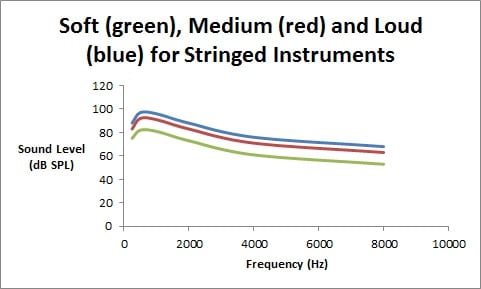This is the last in a four-part series touching on some of the problems associated with selecting the right programming features for a “music program”. Over the last three weeks (actually four since we took a break for the holidays, and I hope you all had a pleasant and relaxing time), I talked about the features of speech and how these may differ from those of music,as well as the various characteristics of reeded and stringed musical instruments.
This week our subject is the brass section of the orchestra. As can be seen in the figure below, brass musical instruments have a different pattern than for soft, medium, and loud speech and also for soft, medium, and loud reeded woodwinds. It is, however, identical to that of stringed instruments, which is why the figure says “Stringed Instruments”. Just take some White Out™ and delete the words “Stringed Instruments” on your computer screen and write in “Brass Instruments” instead.
As with stringed instruments, when the playing level of brass instruments increases, the relative spectral shape of the low-frequency region to the higher-frequency region increases uniformly. If there is a 10-dB increase in playing level in the lower-frequency region, there is also exactly a 10-dB increase in playing level in the higher-frequency region.
In this sense, listening to any brass instrument such as a trumpet (or trombone, or tuba, or cornet …) up close in a live playing situation is like turning up the volume control on your hearing aid, radio, or MP3 player. Volume has no effect for stringed or brass instruments other than to increase the volume. It will not affect the spectral balance.
As with stringed instruments (see part 3), a linear program may be the best algorithm to use for brass instruments as well. But as I mentioned in Part 3, this is an empirical study and it can be determined objectively whether a linear or a level-dependent compression characteristic (i.e., same as for speech in quiet) is optimal.
Below, are the spectral curves for soft playing, medium playing, and loud playing for the stringed instruments from part 3 of this blog. This is identical to what would be expected for brass instruments as well. There are, however, some interesting differences between stringed and brass instruments.
Brass instruments do sound different from stringed instruments and one major reason is that brass (and the clarinet in the lower register) function as quarter-wavelength resonators- like the acoustic output of a behind-the-ear hearing aid. With quarter-wavelength resonators (“closed” at one end and “open” at the other), we have odd-numbered multiples of the fundamental (note name). If a violin is playing 250 Hz (roughly middle C), then there will be be integer harmonics at 500 Hz, 750Hz, 1000 Hz, and so on. In contrast, if a trumpet is playing 250 Hz, the harmonics will be at 750 Hz ( 3 x 250 Hz), 1250 Hz (5 x 250 Hz), 1750 Hz (7 x 250 Hz), and so on.
With brass instruments, the harmonic structure is far less dense than that of speech or stringed instruments. For a 250-Hz fundamental, from 250 Hz to 4000 Hz, a violin would generate 14 harmonics, whereas a trumpet would generate only about 7 harmonics. Each harmonic can be thought of as an energy cue, so one could argue that there are roughly twice the energy cues in stringed instruments (and speech) than for brass instruments.
This harmonic sparseness has been studied in the past and is an issue in perception. But, as in the case of the missing fundamental, our brains have an amazing ability to put back missing elements of sound (and vision). Our brains fill in things that we don’t hear and it is possible that, despite the spectral sparseness of brass instruments (and clarinet in the lower register), this has implications for fitting hearing aids, but I am not sure about this.







